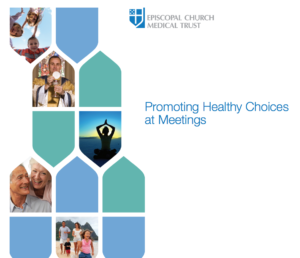 This Guide was developed by Medical Trust for workplaces — but the ideas here apply to congregational meetings as well.
This Guide was developed by Medical Trust for workplaces — but the ideas here apply to congregational meetings as well.
Scheduling meetings:
- Try to limit the number of meetings that are held on any given day
- When possible, limit meetings to 50 minutes – or less
- For longer meetings, allow for periodic breaks – at least 1/50 minutes
- For shorter meetings – consider walking or standing meetings
Meeting locations:
- Select rooms that can comfortably seat all participants
- Rooms with windows are preferred
- When possible, schedule a meeting outside Conventions and offsite meetings – consider sites that provide healthy food options and opportunities for physical activity
Refreshments:
- Determine which meetings require refreshments – not all meetings do
- Offer healthier food options
- Offer water instead of other beverages
- Try not to schedule meetings over the lunch hour, when possible
- Select a caterer/restaurant who offers healthier options
- Work with groups who prepare food
- Consider dietary restrictions/allergies and preferences
Incorporate movement:
- Encourage movement before, during and after meetings
- Suggest movement that can be done sitting or standing so all employees can be included
- Have employees suggest types of movement to allow fuller participation
- Use ‘icebreakers’ to get increased interaction and creativity
Sustainability:
- Make your meetings green – less paper, less waste
- Recycle cans, bottles, papers, etc.
- Come up with new ideas to make meetings ‘green’
Scheduling Meetings:
When days are filled with one meeting after another it appears that a lot of work is getting done. But if there aren’t breaks in between the meetings and staff has to run from one meeting to the next, most people will hit “meeting burnout”! You may want to set a policy that no more than four meetings (you pick the number) can take place on any given day. Limiting the number of meetings allows staff to work on other projects and to feel more refreshed when meetings are more spread out over the course of a day or a week. Sticking to this policy as much as possible lets staff know you value their work time and don’t want to overload their schedules.
To get more physical activity into your daily lives, you can encourage this at your office by making sure that meetings don’t last more than 50 minutes, or if they are longer than an hour that there is a break time during which movement is encouraged.
If the meeting you are scheduling only involves one or two other staff members, you may want to suggest a walking meeting. On nice days, a walk outside can really be a breath of fresh air and clear your mind while talking about an issue.
Standing meetings are becoming more popular. Standing meetings can be held when there is a short agenda and the meeting won’t last more than a half hour. Because people are standing they are more likely to move through the subject matter more quickly and not get off track.
DOWNLOAD Promoting Healthy Choices at Meetings for more ideas — including a list of healthy food choices.
